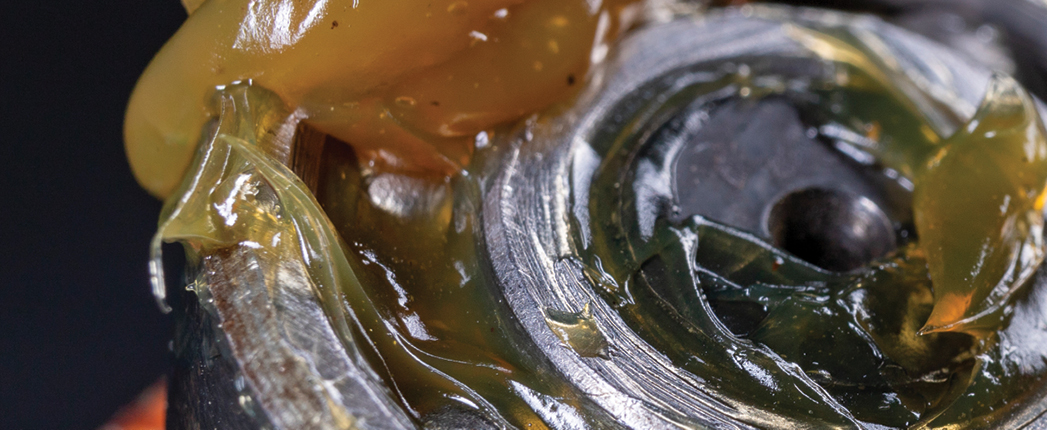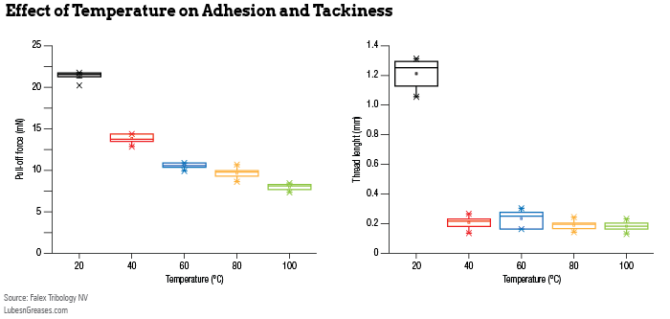
Quantifying Tackiness and Adhesion in Greases
Standardization of test methods in the lubricants industry is neither a quick nor an easy process. “The road to standardization is quite a long road,” Emmanuel Georgiou, project and commercialization manager for Falex Tribology NV, said in a presentation at the Society of Tribologists and Lubrication Engineers Annual Meeting and Exhibition earlier this year. Georgiou and his team have been working to develop a standardized test method to quantify the tackiness and adhesion properties of grease.
A few basic steps go into standardizing such a test method. “First, you need to understand what tackiness and adhesion are,” Georgiou said. “Then you need optimize the procedure in order to have a method that relates to what you are actually observing in reality. After you have a sensitive and repeatable method, then you need to bring that to a repeatable instrument. If you manage to achieve those goals, then you are on the right track to standardize your method.”
So what is adhesion and tackiness in greases?
“Tackiness is the formation of threads when you have a grease that is being pulled apart,” Georgiou said.
On the other hand, adhesion is a grease’s ability to adhere to a substrate, like gears or bearings.
The most common—albeit uncontrolled—way of measuring tackiness is by performing what Georgiou referred to as the “finger test,” in which a sample of grease is applied between a tester’s thumb and pointer finger. The two fingers are then pulled away from each other, and the thread length of the grease is observed. “These threads depend on the retraction speed of your fingers,” Georgiou said. “This test might look a bit primitive, but it is the most reliable test that’s been used until now. However, you cannot get any value for adhesion or tackiness” from this test.
Fortunately, other test methods—like the hammer test or a water spray-off test—have been developed. In the hammer test, a 5-pound hammer head is dropped onto a sample of grease that has been applied to an anvil. The distance that the grease is thrown determines its tackiness. This method is not well controlled and measures the consistency of the grease upon impact but provides inadequate information about adhesion or tackiness properties.
The water spray-off test evaluates the ability of a grease to adhere to a metal panel when subjected to direct, intense water spray.
“These tests focus on different aspects,” Georgiou said. “For example, the water spray-off test gives you a better indication of the adhesion rather than tackiness.”
Because other test methods fall short, “there is a clear need for an objective method that can quantify tackiness and adhesion,” Georgiou said.
Why are adhesion and tackiness important properties to measure in greases? “The reason why we are so interested in measuring those values is that they seem to have quite high importance in determining the friction in several systems,” Georgiou said. “What do I mean by that? Let’s take as an example gears. When those gears are moving relative to each other, you have grease being transferred from one gear to the other, and therefore tackiness plays a role. Also, grease tends to stick onto the gear, and that is more of an adhesion aspect. So adhesion and tackiness are actually two different things.”
It may seem logical that an ideal grease would need to have “high adhesion, so that you always have grease sticking on your surface, reducing friction,” Georgiou said. “You might also need tackiness, because then you have better transfer. However, that is not always the case because this strongly depends on the application” in which the grease is being used.
For instance, with moving gears, a suitable grease would have an ideal ratio of adhesion and tackiness properties. But what is that ratio, and does it differ based on the application? Georgiou considered greases used in food processing equipment. “There you really don’t want any tackiness because you want to avoid contamination,” he said.
Furthermore, a grease with high adhesion and high tackiness can sometimes increase the energy required for the motion of components. “That increases your energy consumption,” Georgiou said. “That’s why you need to have an optimal ratio between adhesion and tackiness.”
The Method
Due to the shortcomings of other test methods, Georgiou and his team worked to develop a new test method that was both sensitive and repeatable. In the new method, a fixed volume of grease is applied on a standardized holder. A copper indenter is then gradually brought into contact with the grease until a pre-set load is reached. Then the indenter is moved away from the substrate under well-controlled conditions until there is complete physical separation.
The amount of force required to start this physical separation is then determined. As the indenter moves away from the substrate, threads form that resemble those demonstrated in the finger test described above. “The thread length is defined as a displacement that is required from the beginning of the separation motion until the thread is broken—until the point that we can no longer record a force,” Georgiou said. “The pull-off force is identified as the force required to start the physical separation of the indenter from the grease. In addition, the separation energy is defined as the energy needed to fully separate the indenter from the grease by the pull-off force.”
What are the advantages of this method? The test is performed with the aid of high-precision sensors and is quite sensitive, Georgiou said.
The method is also precise enough to pick up on certain sub-phenomena. “This precision allows us to differentiate between different greases,” Georgiou said. “The test can shed light on precisely how much different ratios of tackifier to base grease can influence thread length. You can see that by increasing the tackifier amount, you can form longer threads, which corresponds to the finger test.”
Furthermore, by measuring the thread length and the pull-off force for the base grease with different tackifier amounts, “we can see that the increase of tackifiers indeed increases thread length,” Georgiou said. “But it has a vice-versa influence on the adhesion. This clearly indicates that there’s no positive correlation between the tackifier and the pull-off force. Therefore, adhesion is something completely different than tackiness.”
The test also allows formulators to investigate different types and formulations of greases. After performing the test, Georgiou’s team found that increasing the tackifier amount does not always mean that tackiness is increased. By “increasing the tackifier amount to 1%, you get longer threads,” Georgiou said. “But when you go to a higher percentage, you tend to form some gel-like grease, and no threads are formed.”
It is important to note that the results of this new test method are very condition dependent. “We have a sensitive process that allows us to differentiate between different types of greases,” Georgiou said. “However—as demonstrated in the finger test—depending on the retraction speed, you get different thread lengths. This means that tackiness and adhesion are not just individual values, but both strongly depend on contact conditions. By changing the retraction speed, you can get a completely different pull-off force. … When you define a tackiness or adhesion number, you should always refer to the conditions” by which that number was obtained.
The adhesion and tackiness properties of greases are also dependent on temperature. “By going from 20 to 100 degrees Celsius, you see a completely different behavior of your grease in terms of adhesion and thread length,” Georgiou emphasized.

The test equipment used also plays a role. “Something that we sometimes forget is that adhesion and tackiness are system properties,” Georgiou said. “So it always depends on the indenter that you are using and the substrate, because the grease tends to adhere onto the substrate.”
To illustrate this, Georgiou and his team affixed an anti-stick paper in the holder and ran the test again to gauge how the substrate affects test results. “In terms of thread length, we don’t see a difference,” Georgiou said. “But in terms of adhesion, the pull-off force dropped significantly. This means that thread length is more of an intrinsic property of the grease, rather than the pull-off force, which strongly depends on the substrate.”
This means that this method allows for the substrate to be changed out to better simulate the working conditions of the grease.
“By using this method, you can rank different types of greases, whether they be commercial greases or greases you have formulated in your own lab,” Georgiou said. “You can get a realistic ranking in terms of the force and the thread length. By getting all this data, you can make a three-dimensional mapping of your greases, so as to see where you have optimal work conditions. This can be in terms of the temperature, speed, load and other conditions.”
Other possibilities for this test method include determining how the pull-off force or thread length of a grease that has been used in a particular application differs from the same grease that has yet to be used in service.
Repeatability Reigns
While this new test method certainly has several advantages, perhaps one of its greatest attributes is its repeatability. To prove that the method possesses this trait, though, Georgiou and his team “performed different types of testing, and the first one was to run the test with the same user and the same type of grease but to use different modules,” he said. “We got the same, or similar, mean values of pull-off force and thread length that can range between 5%-15% from one module to the other.”
Georgiou and his team again did a similar type of testing, but this time with the goal of determining if different operators could yield comparable results. The grease, test conditions and module were all the same as in initial test runs, but the operator was different. “Again, you get similar mean values of pull-off force and thread length for the same grease, ranging again from 5%-15%,” he said. “This means that this method is repeatable enough.”
Georgiou said that this test method is still on the road to becoming a standardized method but that it has high potential.
Sydney Moore is managing editor of Lubes’n’Greases magazine. Contact her at Sydney@LubesnGreases.com